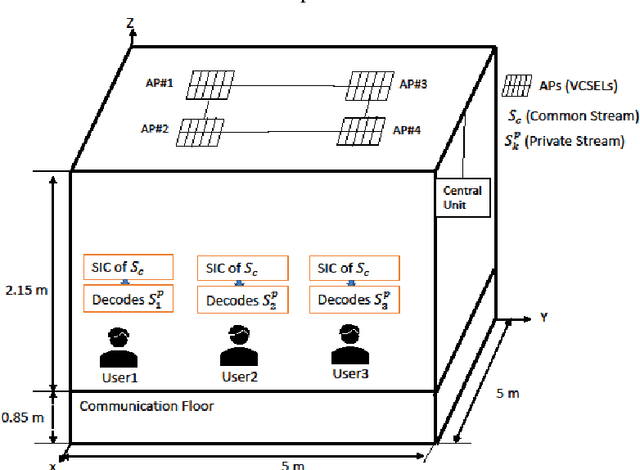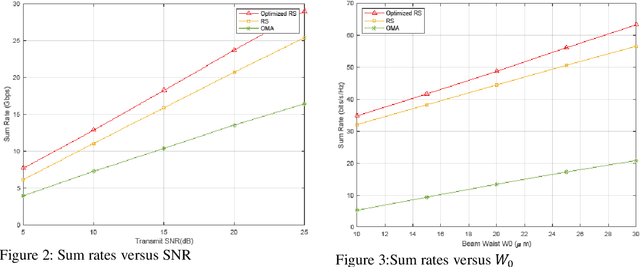Ahmad Adnan Qidan
Predictive and Proactive Power Allocation For Energy Efficiency in Dynamic OWC Networks
May 03, 2025



Abstract:Driven by the exponential growth in data traffic and the limitations of Radio Frequency (RF) networks, Optical Wireless Communication (OWC) has emerged as a promising solution for high data rate communication. However, the inherently dynamic nature of OWC environments resulting from user mobility, and time-varying user demands poses significant challenges for enhanced and sustainable performance. Energy efficiency (EE) is a critical metric for the sustainable operation of next generation wireless networks. Achieving high EE in dynamic OWC environments, especially under time-varying user distributions and heterogeneous service requirements, remains a complex task. In this work, we formulate a discrete-time EE optimisation problem in a dynamic OWC to maximise energy efficiency through determining user connectivity and power allocation. Solving this problem in real time is computationally demanding due to the coupling of user association and power allocation variables over discrete time slots. Therefore, we propose a Probabilistic Demand Prediction and Optimised Power Allocation (PDP-OPA) framework which predicts user arrivals, departures, and traffic demands. Based on these predictions, the framework proactively determines AP-user associations and allocates power dynamically using a Lagrangian-based optimisation strategy. Simulation results demonstrate that the proposed PDP-OPA significantly enhances system performance, providing solutions close to the optimal ones. The proposed framework improves energy efficiency, sum rate, and bit error rate (BER) compared to distance-based user association and uniform power allocation, validating its effectiveness for real time and adaptive resource management in dynamic OWC systems.
Two-Agent DRL for Power Allocation and IRS Orientation in Dynamic NOMA-based OWC Networks
Apr 26, 2025Abstract:Intelligent reflecting surfaces (IRSs) technology has been considered a promising solution in visible light communication (VLC) systems due to its potential to overcome the line-of-sight (LoS) blockage issue and enhance coverage. Moreover, integrating IRS with a downlink non-orthogonal multiple access (NOMA) transmission technique for multi-users is a smart solution to achieve a high sum rate and improve system performance. In this paper, a dynamic IRS-assisted NOMA-VLC system is modeled, and an optimization problem is formulated to maximize sum energy efficiency (SEE) and fairness among multiple mobile users under power allocation and IRS mirror orientation constraints. Due to the non-convex nature of the optimization problem and the non-linearity of the constraints, conventional optimization methods are impractical for real-time solutions. Therefore, a two-agent deep reinforcement learning (DRL) algorithm is designed for optimizing power allocation and IRS orientation based on centralized training with decentralized execution to obtain fast and real-time solutions in dynamic environments. The results show the superior performance of the proposed DRL algorithm compared to standard DRL algorithms typically used for resource allocation in wireless communication. The results also show that the proposed DRL algorithm achieves higher performance compared to deployments without IRS and with randomly oriented IRS elements.
ANN-Driven Adaptive Power Allocation for OWC
Apr 06, 2025Abstract:Vertical-cavity surface-emitting lasers (VCSELs) have gained popularity in Optical Wireless Communication (OWC) due to their high bandwidth and directional beam compared to Light-emitting diodes (LEDs). In this work, we explore the deployment of VCSELs as Access Points (APs) in an indoor environment with time-varying user distributions and traffic demands. To enhance performance, a merged access point (MAP) topology is introduced to extend the serving area of each cell using Zero Forcing (ZF) for interference management. A power allocation optimisation problem is formulated aimed at maximising the sum rate of the dynamic network. Deterministic approaches can solve the formulated problem but are impractical for real-time scenarios. In this work, we propose an Artificial Neural Network (ANN) for adaptive power allocation with reduced computational complexity. Our results show that the designed ANN learns and effectively provides instantaneous solutions in dynamic scenarios, resulting in improved performance in terms of sum rate compared to a baseline uniform power allocation scheme.
Energy Efficient Service Placement for IoT Networks
Apr 25, 2024Abstract:In recent years, there has been a significant expansion in the Internet of Things (IoT), with a growing number of devices being connected to the internet. This has led to an increase in data collection and analysis as well as the development of new technologies and applications. The rise of IoT has also brought about new challenges, such as security concerns and energy efficiency. This study investigates a layered IoT architecture that combines fog and cloud computing, aiming to assess the impact of service placement on energy efficiency. Through simulations, we analyse energy use across Access Fog, Metro Fog, and Cloud Data Centre layers for different IoT request volumes. Findings indicate that Access Fog is optimal for single requests, while Metro Fog efficiently manages higher demands from multiple devices. The study emphasizes the need for adaptive service deployment, responsive to network load variations, to improve energy efficiency. Hence, we propose the implementation of dynamic service placement strategies within Internet of Things (IoT) environments.
Intelligent Reflecting Surfaces assisted Laser-based Optical Wireless Communication Networks
Apr 02, 2024Abstract:The increasing demand for wireless networks of higher capacity requires key-enabling technologies. Optical wireless communication (OWC) arises as a complementary technology to radio frequency (RF) systems that can support high aggregate data rates. However, OWC systems face some challenges including beam-blockage. Intelligent reflecting surfaces (IRSs) can offer alternative pathways for the optical signal, ensuring continuous connectivity. In this work, we investigate the potential of using IRS in an indoor OWC network. In particular, we define a system model of indoor OWC that employs IRS in conjunction with angle diversity transmitters (ADT) using vertical-cavity surface-emitting laser (VCSEL) arrays. The VCSEL beam is narrow, directed, and easy to block, however, it can deliver high data rates under eye safety regulations. Simulation results show that the deployment of IRS can significantly improve the achievable data rates of Laser-based OWC systems.
Deep Learning-based Power Allocation in Rate Splitting Optical Wireless Networks
Jul 17, 2023Abstract:Optical wireless communication (OWC) provides high aggregate data rates in the range of Terabits per second (Tb/s). Specifically, OWC using infrared lasers as transmitters has been considered as a strong candidate in the next generation of wireless communication. Rate splitting (RS) is a transmission scheme derived to improve spectral efficiency in dense wireless networks. In RS, the transmitted power is allocated to different messages, common and private messages, serving multiple users simultaneously, where each user can decode the desired message following a certain procedure. Moreover, two-tier precoding RS scheme has been proposed to overcome the limitations of traditional RS in multi-group scenarios. In this context, power allocation (PA) is a crucial issue, which can affect the performance of RS. Therefore, we formulate a PA optimization problem to enhance the data rates of RS-based OWC networks. However, such optimization problems are complex due to the use of different messages intended to the users. In this paper, we design and train a deep neural network (DNN) model to determine the power allocated to the messages of RS, while fulfilling the demands of users. The results show the accuracy of our trained DNN model when used in an online phase.
AI-Driven Resource Allocation in Optical Wireless Communication Systems
Apr 08, 2023Abstract:Visible light communication (VLC) is a promising solution to satisfy the extreme demands of emerging applications. VLC offers bandwidth that is orders of magnitude higher than what is offered by the radio spectrum, hence making best use of the resources is not a trivial matter. There is a growing interest to make next generation communication networks intelligent using AI based tools to automate the resource management and adapt to variations in the network automatically as opposed to conventional handcrafted schemes based on mathematical models assuming prior knowledge of the network. In this article, a reinforcement learning (RL) scheme is developed to intelligently allocate resources of an optical wireless communication (OWC) system in a HetNet environment. The main goal is to maximise the total reward of the system which is the sum rate of all users. The results of the RL scheme are compared with that of an optimization scheme that is based on Mixed Integer Linear Programming (MILP) model.
Energy Efficient Laser-Based Optical Wireless Communication Networks
Apr 07, 2023Abstract:Rising data demands are a growing concern globally. The task at hand is to evolve current communication networks to support enhanced data rates while maintaining low latency, energy consumption and costs. To meet the above challenge, Optical Wireless Communication (OWC) technology is proposed as a solution to complement traditional Radio Frequency (RF) based communication systems. Recently, Vertical Cavity Surface Emitting Lasers (VCSELS) have been considered for data transmission in OWC indoor environments due to their ability to transmit power through narrow, near-circular beams to receivers. In this paper, we study the energy efficiency of a VCSEL-based OWC system in an indoor environment and compare it to that of a Light Emitting Diode (LED) based system. The main findings show that the VCSEL system performs better and has higher energy efficiency.
Rate Splitting for 6G Optical Wireless Networks
Apr 06, 2023


Abstract:This paper evaluates the performance of rate splitting (RS), a robust interference management scheme, in an optical wireless communication (OWC) network that uses infrared lasers referred to as vertical-cavity surface-emitting lasers (VCSELs) as optical transmitters. In 6G OWC, providing high spectral and energy efficiency requires advanced multiple access schemes that can serve multiple users simultaneously in a non-orthogonal fashion. In this context, RS has the potential to manage multi-user interference at high data rates compared to orthogonal transmission schemes. Simulation results show the high performance of RS compared to baseline approaches.
Multi-User Rate Splitting in Optical Wireless Networks
Jul 23, 2022



Abstract:Optical wireless communication (OWC) has recently received massive interest as a new technology that can support the enormous data traffic increasing on daily basis. Laser-based OWC networks can provide terabits per second (Tbps) aggregate data rates. However, the emerging OWC networks require clusters of optical transmitters to provide uniform coverage for multiple users. In this context, multi-user interference (MUI) is a crucial issue that must be managed efficiently to provide high spectral efficiency. Rate splitting (RS) is proposed as a transmission scheme to serve multiple users simultaneously by splitting the message of a given user into common and private messages, and then, each user decodes the desired message following a certain procedure. In radio frequency (RF) networks, RS provides higher spectral efficiency compared with orthogonal and non-orthogonal transmission schemes. Considering the high density of OWC networks, the performance of RS is limited by the cost of providing channel state information (CSI) at transmitters and by the noise resulting from interference cancellation. In this work, a user-grouping algorithm is proposed and used to form multiple groups, each group contains users spatially clustered. Then, an outer precoder is designed to manage inter-group interference following the methodology of blind interference alignment (BIA), which reduces the requirements of CSI at RF or optical transmitters. For intra-group interference, RS is applied within each group where the users belonging to a given group receive a unique common message on which their private messages are superimposed. Furthermore, an optimization problem is formulated to allocate the power among the private messages intended to all users such that the sum rate of the network is maximized.
 Add to Chrome
Add to Chrome Add to Firefox
Add to Firefox Add to Edge
Add to Edge